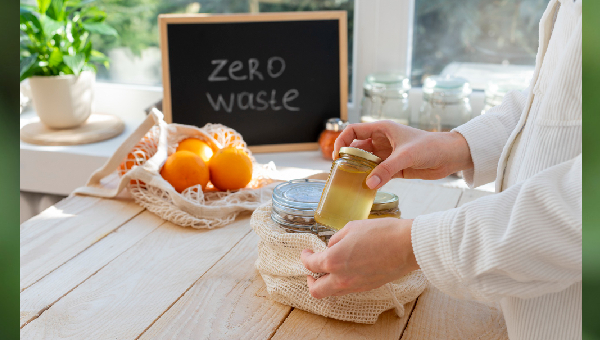How to Start a Zero-Waste Lifestyle: A Beginner’s Guide

Waste Creation is probably the biggest problem that the world has today and therefore the need to eliminate waste is becoming fashionable. Living in a zero-waste world calls for coming to a point where waste is minimized. This means that the amount of waste going to the landfills is greatly reduced, while more materials are used instead of going to waste or being deposited idle in the landfills. To those people who have never attempted such an approach process may seem complicated at the beginning, but after a few simple things are introduced, one can start on this journey to green living. So for those who are aspiring to learn how to live with zero waste in their household, this article will greatly help you.
Understanding the Zero-Waste Lifestyle
Zero waste places management and lifestyle within the context of resources – waste away buildings and other valuables in the home feeder and appliance marketplace buyers, and food wastes dropped on the streets. Before we get into the step-by-step procedure, let us first explain what exactly is meant by the term zero waste. Individual advocates aim to combat waste by practicing consumption - only purchasing goods that will help decrease the need for more plastic items. The five aspirations also known as the five R’s are refuse, reduce, reuse, recycle and rot. Adhering to these principles makes it possible to still further curtail the volume of waste produced.
Step 1: Assess Your Current Waste
The initial course of action in pursuing a zero-waste lifestyle is to examine how much waste an individual produces and how it is disposed of. For one week, number each sort of squander that you simply deliver. Write down every disposal that you make for food, plastic wrappers, etc. This will give you a good perspective on the major sources of your waste and what steps should be tackled first.
Step 2: Don’t Accept Things You Don’t Need
One of the backbones of a zero-waste lifestyle is not allowing oneself to acquire things one does not require. It means staunchly refusing single-use plastics, unnecessary plastic wraps, and anything that is destined for the landfill fairly quickly. To begin with, you might want to decline the option of using plastic straws, plastic cutlery or plastic bags. Carry your own – reusable ones whenever required. By refusing they stop the inclusion of swept-out imperishable materials into the house from the start.
Step 3: Cut Down on Your Consumption
The third phase is to reduce the scope of activities and items one buys. Concentrate on fewer, better-quality items. Opt for long-lasting and high-quality items instead of reasonable-priced items that are disposable. Less consumption of products also means less wasting of food. When it comes to food, planning what to eat, reusing what can be reused, and getting only what is needed would prevent excess unnecessary food purchases.
Step 4: Recycle and Upcycle
Recovery of material is the key approach to achieving a global goal of zero waste. Browse your assets before buying anything new. For instance, unused glass jars could be used for business, torn clothes can be made into rags or any unwanted container can be used. Second-hand clothes, furniture and other items are the best fit in this Method where people shop for new items. In summary for instance, in this example of reuse, you thrifty blankets can shop these in the Method whereby used furniture can be purchased.
Step 5: Get Familiar with Recycling
Although reducing waste in every possible way is the aim, recycling also complements this endeavor. You need to make sure that you adhere to proper procedures when it comes to recycling in your community by learning all the requirements. Institute such categories as paper, glass, metals, plastics and many others in your waste disposal management. Some plastic products can be recycled but that will depend on individual districts or counties on what can be recycled.
Step 6: Do Not Throw Away Clean Organic Waste
Of all the waste management practices composting organic waste is one of the best methods that can be effectively relied upon. Instead of just wasting food scraps, coffee and yard waste, comes a way that helps you in the clean and proper disposal of those kinds of wastes. Not only is composting able to decrease the amount of waste that hits the landfills but it is also done to produce soil favorable for gardening purposes. In case you don’t have room for a composting bin, you can look for cities that have some form of programs and services for composting.
Step 7. Start Small and Gradually Build Up
It takes effort and time to transform one’s lifestyle, and it also does not happen instantly to become an advocator for zero-waste living. It is something that would take time, effort, and gradual adjustments. For instance, rather begin with easy and small ones, say refuse plastic straws and use personal shopping bags. After getting used to certain modifications you can try and take up certain measures which would require fewer resources than mastering a skill meant to reduce domestic consumption.
Step 8. Learn New Things and Keep Getting Motivated
The zero waste movement is very dynamic and one is always able to acquire new tips and tricks as well as approaches to stewardship from time to time. One can do this by following zero waste blogs, reading books on sustainability, and joining online forums where one can post their experience and learn from other series. For such reasons, it would be crucial to educate yourself so that when such times arise, you will be able to eradicate as much waste as possible.
Step 9: Involve Your Community
A zero-waste lifestyle cannot only be enforced by individual practices but by encouraging participation from the residents as well. Communicate your thoughts together with your relatives and colleagues. Ask them to come along with you and make some changes in their lifestyles as well. You can also join other environmentally friendly societies in your neighborhood or form one. The more the people you bring in the more the wastage you will be able to reduce.
Step 10: Celebrate Your Progress
In addition, in the process, it is useful at this stage to what you have done, no matter how little it might appear to be. The fight against waste cannot be passive, rather each step is a conducive move towards a reduction of the waste a person produces. Think about what you have accomplished so far, and pay attention to all the good things that have happened to you and your surroundings. Such landmarks will help you maintain focus together with progress on your zero waste campaign.
Common Challenges Faced and Their Solutions
Starting a zero-waste lifestyle has its own set of obstacles. For example, one of the concerns is not being able to find zero-waste options, particularly in regions with only a limited number of sustainable options. In such situations, think of making your cleaning products or baking snacks to limit packaging. Another challenge is dealing with non-cooperative family members or friends. In such a situation, it is best to take the lead, show your accomplishments, and leave other people to change without any expectations.
One more possible difficulty is the feeling of guilt caused by not following the principle of zero waste “to the letter”. This answer does not need to be stressed, as after all, nobody is saying you need to be a perfect zero-waste person. There is no such thing as achieving zero waste because it is a linear description that relates only to a certain point in time.
Conclusion
Pursuing a zero-waste lifestyle is rewarding in all aspects since it is good for the environment and also promotes a happier engagement. By implementing these guidelines and the methods of reducing and preventing to focus on those principles over some time you will be able to cut all waste footprints drastically. Don't disregard that the intention isn't to realize optimism and the thought is to develop all the time. Flower up but do not rush to the line, for every dangerous step, let it be slow and positive, and push yourself for changes that are going to be made on your person and the earth as well.








